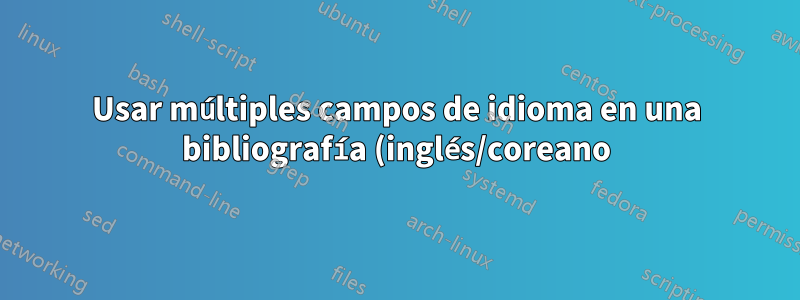.png)
Esta es una aclaración deesta preguntayusa ese MWE. El MWEtítulo original,editor originalLos campos, etc. aún no están completamente completos.
@article{Ka91,
origtitle = {투자은행이 IPO의 가격형성에 미치는 영향에 관한 실증분석},
origpublisher = {재무관리연구}
title = {An Empirical Study on ...},
publisher = {The Korean Journal of Financial Management}
origlanguage = {Korean},
}
Ahora puedo separar mis bibliografías en secciones en inglés y coreano.
Ahora me gustaría imprimir el texto en inglés en las Biblias en inglés y el texto en coreano en la Biblia en coreano. (Artículos 1 y 2 en la imagen). Una tercera posibilidad es una bibliografía combinada como se muestra en el punto 3. Esto fue copiado de un artículo enRevisión asiática de la investigación financierapágina 34 o algo así.
Si es más sencillo, puedo prescindir de localizar "Vol.", "No". etc.
Edite para agregar un MWE coreano más completo según lo solicitado por Moewe. El texto está tomado deWikipediay pegado. Debe compilarse con xelatex, pdflatex no funciona.
\documentclass{report}
\usepackage[utf8]{inputenc}
\usepackage[a4paper,width=150mm,top=25mm,bottom=20mm,bindingoffset=10mm]{geometry}
\usepackage{multirow}
\usepackage{libertine}
\setmainfont{Linux Libertine O}
\usepackage{CJKutf8}
\usepackage{xeCJK}
\setCJKmainfont[Mapping=Jamo]{UnGungseo.ttf}
\setCJKsansfont{UnGungseo.ttf}
\setCJKmonofont{gulim.ttf}
\begin{document}
\section*{Korean Mixed Script}
Korean mixed script, known in Korean as hanja honyong (Korean: 한자혼용; Hanja: 漢字混用), Hanja-seokkeosseugi (漢字섞어쓰기, 한자섞어쓰기), 'Chinese character mixed usage,' or gukhanmun honyong (국한문혼용; 國漢文混用), 'national Sino-Korean mixed usage,' is a form of writing the Korean language that uses a mixture of the Korean alphabet or hangul (한글) and hanja (漢字, 한자), the Korean name for Chinese characters. The distribution on how to write words usually follows that all native Korean words, including grammatical endings, particles and honorific markers are generally written in hangul and never in hanja. Sino-Korean vocabulary or hanja-eo (한자어; 漢字語), either words borrowed from Chinese or created from Sino-Korean roots, were generally always written in hanja although very rare or complex characters were often substituted with hangul. Although the Korean alphabet was introduced and taught to people beginning in 1446, most literature until the early twentieth century was written in literary Chinese known as hanmun (한문; 漢文).
\begin{table}[ht]
\centering
\begin{tabular}{ll}
\hline
Chinese Original & 有朋自遠方來 不亦樂乎 \\ \hline
1590 translation by Yi Yulgok & 朋이 遠方으로브터 오리이시면 樂흡디 아니랴 \\
Hangul-only transcription of 1590 translation & 붕이 원방으로브터 오리이시면 낙흡디 아니랴 \\
\multirow{3}{*}{Modern Korean gloss} & 벗(동문-혹은 뜻을 같이 하는 이)이 있 \\
& 멀리서부터 사방에서 \\
& \begin{tabular}[c]{@{}l@{}}어 오니 혹은 먼 곳에서 오니 \\ 또한 즐겁지 아니한가?\end{tabular} \\
English translation & Having oneself friends arriving from distant regions, \\ & is that not happiness? \\ \hline
\end{tabular}
\end{table}
\end{document}




